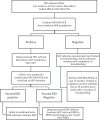Point-of-Care Early Infant Diagnosis Improves Adherence to the Testing Algorithm in Kenya
- PMID: 32052676
- PMCID: PMC7019379
- DOI: 10.1177/2325958220906030
Point-of-Care Early Infant Diagnosis Improves Adherence to the Testing Algorithm in Kenya
Abstract
Introduction: We determine the level of adherence to the revised Kenya early infant diagnosis (EID) algorithm during implementation of a point-of-care (POC) EID project.
Methods: Data before (August 2016 to July 2017) and after (August 2017 to July 2018) introduction of POC EID were collected retrospectively from the national EID database and registers for 33 health facilities. We assessed the number of HIV-infected infants who underwent confirmatory testing and received baseline viral load test and proportion of infants with an initial negative result who had a subsequent test.
Results and discussion: Significantly higher number of infants accessed confirmatory testing (94.2% versus 38.6%; P < .0001) with POC EID. Baseline viral load test and follow-up testing at 6 months, although higher with POC EID, were not significantly different from the pre-POC EID intervention period.
Conclusion: The POC EID implementation has the potential to increase proportion of infants who receive confirmatory testing, thus reducing the risk of false-positive results.
Keywords: HIV; adherence; algorithm; early infant diagnosis; point of care.
Conflict of interest statement
Figures
Similar articles
-
Evaluation of a routine point-of-care intervention for early infant diagnosis of HIV: an observational study in eight African countries.Lancet HIV. 2019 Jun;6(6):e373-e381. doi: 10.1016/S2352-3018(19)30033-5. Epub 2019 Apr 12. Lancet HIV. 2019. PMID: 30987937
-
Impact of Routine Point-of-Care Versus Laboratory Testing for Early Infant Diagnosis of HIV: Results From a Multicountry Stepped-Wedge Cluster-Randomized Controlled Trial.J Acquir Immune Defic Syndr. 2020 Jul 1;84 Suppl 1(1):S5-S11. doi: 10.1097/QAI.0000000000002383. J Acquir Immune Defic Syndr. 2020. PMID: 32520909 Free PMC article. Clinical Trial.
-
Point-of-care HIV maternal viral load and early infant diagnosis testing around time of delivery at tertiary obstetric units in South Africa: a prospective study of coverage, results return and turn-around times.J Int AIDS Soc. 2020 Apr;23(4):e25487. doi: 10.1002/jia2.25487. J Int AIDS Soc. 2020. PMID: 32329186 Free PMC article.
-
Systematic review of the performance and clinical utility of point of care HIV-1 RNA testing for diagnosis and care.PLoS One. 2019 Jun 27;14(6):e0218369. doi: 10.1371/journal.pone.0218369. eCollection 2019. PLoS One. 2019. PMID: 31246963 Free PMC article.
-
Clinical/Laboratory Interface Interventions to Improve Impact of Viral Load and Early Infant Diagnosis Testing Scale-Up.AIDS Res Hum Retroviruses. 2020 Jul;36(7):550-555. doi: 10.1089/AID.2019.0266. Epub 2020 Mar 12. AIDS Res Hum Retroviruses. 2020. PMID: 32070109 Review.
Cited by
-
High Prevalence of Unconfirmed Positive HIV Polymerase Chain Reaction Test Results Among African Infants With HIV Exposure in the International Epidemiology Databases to Evaluate AIDS Consortium.Clin Infect Dis. 2024 Dec 17;79(6):1475-1478. doi: 10.1093/cid/ciae251. Clin Infect Dis. 2024. PMID: 38742844 Free PMC article.
-
Delays in HIV-1 infant polymerase chain reaction testing may leave children without confirmed diagnoses in the Western Cape province, South Africa.Afr J Lab Med. 2022 Jun 23;11(1):1485. doi: 10.4102/ajlm.v11i1.1485. eCollection 2022. Afr J Lab Med. 2022. PMID: 35811753 Free PMC article.
References
-
- Joint United Nations Programme on HIV/AIDS. Global HIV & AIDS Statistics—2018 Fact Sheet. Geneva, Switzerland: Joint United Nations Programme on HIV/AIDS; 2018. http://www.unaids.org/sites/default/files/media_asset/UNAIDS_FactSheet_e.... Accessed July 26, 2019.
-
- Feucht U, Forsyth B, Kruger M. False-positive HIV DNA PCR testing of infants: implications in a changing epidemic. S Afr Med J. 2012;102(3):149–152. - PubMed
-
- World Health Organization. HIV Diagnosis and ARV Use in HIV-Exposed Infants: A Programmatic Update. Geneva, Switzerland: World Health Organization; 2018.
Publication types
MeSH terms
LinkOut - more resources
Full Text Sources
Medical


